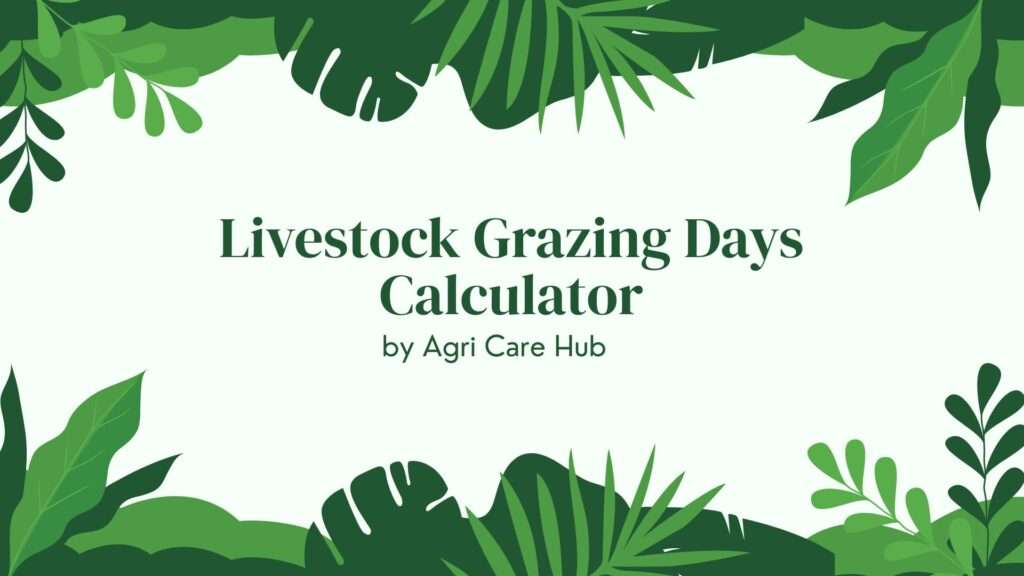Livestock Grazing Days Calculator
About the Livestock Grazing Days Calculator
The Livestock Grazing Days Calculator is a scientifically designed tool to help farmers and ranchers determine how long a pasture can sustain a specific number of livestock. By inputting key variables such as pasture size, forage yield, livestock numbers, and daily consumption rates, this tool provides accurate grazing day estimates based on established forage management principles. Developed with insights from agricultural research, it ensures sustainable pasture management. For more resources on sustainable farming, visit Agri Care Hub.
Importance of the Livestock Grazing Days Calculator
Effective pasture management is critical for sustainable livestock farming. The Livestock Grazing Days Calculator helps farmers optimize grazing schedules, prevent overgrazing, and maintain soil health. Overgrazing can lead to reduced forage availability, soil erosion, and degraded pasture quality, which negatively impacts both livestock productivity and environmental sustainability. By using this calculator, farmers can make data-driven decisions to balance livestock needs with pasture capacity, ensuring long-term productivity. According to research from the USDA, proper grazing management can increase forage production by up to 30%, supporting healthier livestock and ecosystems.
User Guidelines
To use the Livestock Grazing Days Calculator effectively, follow these steps:
- Pasture Size: Enter the size of your pasture in acres. Ensure accurate measurements, as this directly affects the calculation.
- Forage Yield: Input the estimated forage yield in pounds per acre. This can be obtained from local agricultural extension services or soil tests.
- Number of Livestock: Specify the number of animals grazing on the pasture. This should reflect the total herd size.
- Daily Consumption Rate: Enter the average daily forage consumption per animal in pounds. Typical values range from 2-3% of body weight, depending on the species (e.g., 25-30 lbs/day for cattle).
- Click "Calculate Grazing Days" to get the result, which indicates how many days the pasture can sustain the livestock without overgrazing.
Always cross-check your inputs with local data or consult agricultural experts for precise forage yield estimates.
When and Why You Should Use the Livestock Grazing Days Calculator
This calculator is essential for farmers planning grazing rotations, managing pasture resources, or transitioning to sustainable farming practices. Use it when:
- Planning seasonal grazing schedules to avoid overgrazing.
- Assessing new pastures for livestock capacity.
- Implementing rotational grazing systems to improve soil health.
- Balancing livestock feed requirements with available forage.
The tool is particularly valuable during drought or variable weather conditions, when forage production may fluctuate. By providing precise grazing day estimates, it helps prevent pasture degradation and supports livestock health, reducing the need for supplemental feed. Studies from the University of Nebraska-Lincoln show that rotational grazing, guided by tools like this, can improve pasture productivity by 20-40%.
Purpose of the Livestock Grazing Days Calculator
The primary purpose of the Livestock Grazing Days Calculator is to promote sustainable livestock management by providing farmers with a reliable, science-based tool. It calculates grazing days using the formula: Grazing Days = (Pasture Size × Forage Yield × Utilization Rate) / (Livestock Number × Daily Consumption Rate). A standard utilization rate of 50% is assumed to account for trampling and selective grazing, as recommended by the Natural Resources Conservation Service (NRCS). This ensures pastures are not overgrazed, maintaining long-term productivity.
The tool also educates farmers on the importance of balancing livestock needs with environmental conservation. Overgrazing contributes to 80% of pasture degradation worldwide, according to FAO reports. By using this calculator, farmers can reduce environmental impact, improve soil fertility, and enhance livestock performance. It supports data-driven decisions, aligning with modern agricultural practices promoted by organizations like Agri Care Hub.
Scientific Basis of the Calculator
The calculations are grounded in peer-reviewed agricultural science. The formula used is derived from standard forage management principles, as outlined by the NRCS and university extension programs. Forage yield estimates are based on dry matter production, typically ranging from 1,000 to 4,000 lbs/acre depending on pasture quality and climate. The utilization rate (50%) accounts for inefficiencies in grazing, such as trampling or selective eating, ensuring conservative and sustainable estimates. This approach aligns with research from institutions like Texas A&M University, which emphasizes sustainable grazing to maintain soil carbon levels.
Benefits of Using the Calculator
Using the Livestock Grazing Days Calculator offers multiple benefits:
- Prevent Overgrazing: Ensures pastures remain productive by avoiding excessive grazing pressure.
- Cost Savings: Reduces reliance on supplemental feed by optimizing natural forage use.
- Environmental Protection: Supports soil health and reduces erosion, contributing to sustainable farming.
- Improved Livestock Health: Ensures animals have adequate forage, supporting weight gain and productivity.
By integrating this tool into your farm management, you align with best practices endorsed by agricultural experts worldwide.
Additional Considerations
For best results, combine the calculator with regular pasture monitoring. Factors like seasonal changes, rainfall, and soil fertility can affect forage yield. Consulting local agricultural extension services or resources like Livestock Grazing Days can provide additional insights. The calculator assumes average conditions, so adjust inputs based on specific pasture data for maximum accuracy.
This tool is part of a broader effort to promote sustainable agriculture. By using it, farmers contribute to global efforts to combat land degradation and improve food security, as highlighted by initiatives from Agri Care Hub.
